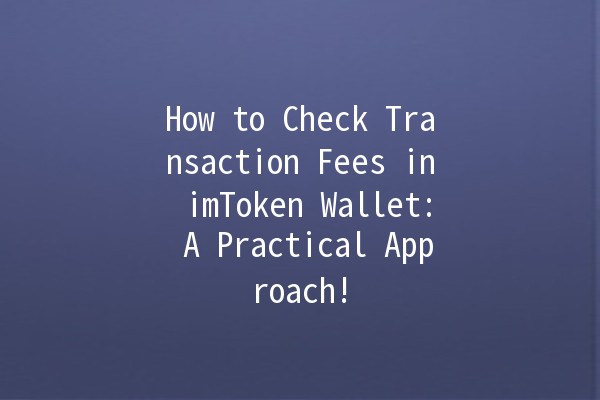In today's fastpaced digital world, cryptocurrency wallets have become an essential tool for managing assets. imToken is one such wallet that enables users to interact with various blockchain networks seamlessly. One of the critical aspects of using any cryptocurrency wallet is understanding transaction fees, as they can significantly impact your overall trading experience. This article aims to provide practical insights on how to check transaction fees in the imToken wallet, along with effective productivity tips.
Transaction fees in the imToken wallet refer to the costs incurred when executing transactions on the blockchain. These fees are necessary to incentivize miners or validators who process and confirm transactions. In the case of imToken, users face different fees depending on the blockchain used (Ethereum, Bitcoin, etc.), network congestion, and the transaction's urgency.

To effectively monitor transaction fees in your imToken wallet, follow these steps:
Regularly check blockchain explorers like Etherscan for Ethereum or Blockstream for Bitcoin. Keeping an eye on network congestion will help you choose the optimal time to perform transactions, thereby saving on fees.
Example: If the Ethereum network shows high congestion in the afternoon, try to schedule transactions during latenight hours when fees tend to drop.
Leverage online tools that provide fee estimations based on current network conditions. Websites like EthGasStation can help you make informed decisions on the right time and fee settings for your transactions.
Example: Before sending funds, use EthGasStation to see the average gas price; if it’s unusually high, consider waiting until it drops.
When needing to send funds to multiple recipients, consider batching your transactions if possible. Instead of sending individual transactions, send one transaction to your destination and have the recipients claim their share.
Example: Instead of sending three separate transactions, send one with three different outputs. This can significantly reduce fees.
Consider conducting transactions during offpeak hours, which often means lower transaction fees due to reduced network activity.
Example: If you notice that transaction fees typically increase during weekdays, aim to complete your transactions on weekends or in less busy hours.
If applicable, utilizing Layer 2 solutions like Polygon or Optimism may help reduce transaction fees considerably. These solutions enable faster and cheaper transactions by processing them off the main Ethereum network.
Example: If your activity involves frequent transactions, using Polygon can mitigate high fees while benefiting from Ethereum’s security.
Transaction fees fluctuate based on several factors, including network congestion, transaction complexity, and the comprehensive data size of the transaction. When more users are trying to process transactions, fees increase as miners prioritize transactions with higher fees.
Unfortunately, transaction fees cannot be entirely avoided as they are fundamental to the functioning of blockchain technology. However, by optimizing your transaction timings and settings, you can minimize these costs.
To view past transaction fees, navigate to the "Transaction History" section of your imToken wallet. Each transaction entry should include the respective fees charged for that transaction.
If you set a fee below the recommended level, your transaction may remain unconfirmed for extended periods. In a worstcase scenario, it may not be processed at all, requiring you to resend it with a higher fee.
While predicting transaction fees is challenging due to the dynamic nature of blockchain networks, historical trends can serve as indicators. Analyzing past fee patterns during specific times can provide rough estimates for future transactions.
Once a transaction is submitted, it cannot be modified. However, if the transaction remains unconfirmed, you may be able to cancel it and resend it with a higher fee, if supported by the wallet.
, managing transaction fees in the imToken wallet involves understanding the underlying factors at play and applying effective strategies. With the tips provided, users can not only optimize their transaction costs but also ensure a more streamlined cryptocurrency trading experience. Embrace these practices to help you navigate the world of blockchain transactions more effectively and efficiently!